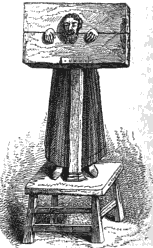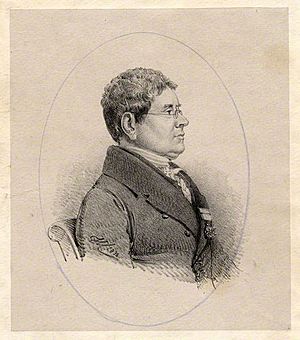Henry Ellis (librarian) facts for kids
Sir Henry Ellis (born November 29, 1777 – died January 15, 1869) was an important English librarian and expert on old things (an antiquarian). For a long time, he was the main librarian at the famous British Museum in London.
Contents
Early Life and School
Henry Ellis was born in London. He went to two schools there: the Mercers' School and Merchant Taylors' School. He was a good student and won a scholarship to St John's College, Oxford University in 1796.
Becoming a Librarian
In 1798, Henry Ellis started working at the Bodleian Library at Oxford University. This was a very important library. In 1800, he moved to the British Museum in London, where he became an assistant in the printed books department.
A few years later, in 1806, there was a change in leadership in his department. This led to Henry Ellis becoming the head of the printed books department. He and his colleague, Henry Hervey Baber, then started a huge project. They worked to create a new, accurate list (catalogue) of all the books in the museum's library. This big job took them many years, from 1807 to 1819.
While working on the catalogue, Ellis also took on other important roles. In 1812, he moved to the manuscripts department, which handled old handwritten documents. In 1814, he became the secretary for the British Museum. In the same year, he also became the secretary for the Society of Antiquaries of London, a group dedicated to studying history and old objects. He was elected a Fellow of the Royal Society in 1811, which showed he was a respected scholar.
In 1827, the main librarian, Joseph Planta, passed away. Henry Ellis, who had already been doing many of the duties, was chosen to take over. He became the Principal Librarian of the British Museum on December 20, 1827. In 1832, he received a special honor from the King, and in 1833, he was knighted, meaning he became "Sir Henry Ellis."
Challenges at the Museum
In the 1830s, the British Museum faced some challenges. Some people, like William Cobbett, criticized how it was run. A special committee from Parliament was set up to look into the museum's operations.
During this time, Sir Henry Ellis explained to the committee why the museum needed to close for a few weeks each autumn. He also mentioned concerns about opening on Saturdays. However, the committee's findings led to big changes in how the museum was managed. Many of the main librarian's duties were given to the secretary, making that role very powerful.
Josiah Forshall became the new secretary in 1837. He, along with other important figures like Anthony Panizzi, took on much of the daily control. Even though Sir Henry Ellis remained the Principal Librarian, his role became less hands-on. Later, the jobs of secretary and principal librarian were combined, and Panizzi became the true leader of the museum.
Later Years and Legacy
Sir Henry Ellis continued to be involved with the Society of Antiquaries of London. He shared the secretary position for a few years and then became the director of the Society from 1853 to 1857.
He was very healthy and continued working until February 1856, when he retired with a pension. He lived for another thirteen years near the museum he had served for so long. Sir Henry Ellis passed away at his home on January 15, 1869.
His Works and Contributions

Sir Henry Ellis was a busy writer and editor. In 1798, when he was only 21, he published a book about the history of a place called St. Leonard's, Shoreditch. He also wrote many articles for Archaeologia, a journal about old things. In 1813, he edited a book called Popular Antiquities by John Brand, which explored old customs and traditions.
Catalogues and Collections
In 1816, he published a catalogue of the old handwritten documents (manuscripts) belonging to the Society of Antiquaries. He also worked on important historical records. He helped publish parts of the Domesday Book, which was a survey of England from the 11th century.
Between 1817 and 1833, he helped create a new edition of Monasticon by William Dugdale, a large work about monasteries. Using his position at the museum, he published Original Letters illustrative of English History. This was a collection of old letters that helped explain English history, mostly taken from the museum's own collection. He published three series of these letters between 1824 and 1846. He also wrote guides to help visitors explore the different parts of the British Museum.
Sir Henry Ellis helped complete parts of the British Museum's main book catalogue. This was a massive undertaking to list all the books in the museum's collection.
Studying Coins
Sir Henry Ellis was one of the people who helped start the Royal Numismatic Society in 1836. This society is for people who study coins and medals (numismatics). At the very first meeting in 1837, he gave the first presentation, talking about old coins called farthings from Queen Anne's time. He also wrote several articles about coins for the Numismatic Chronicle, including articles about ancient coins from Northumbria and coins from York.


